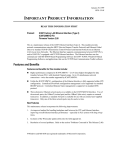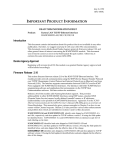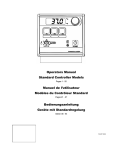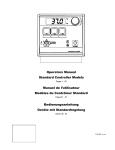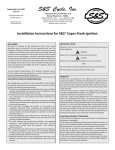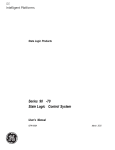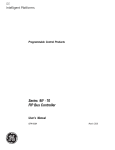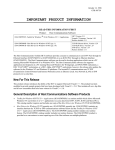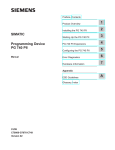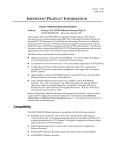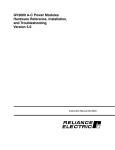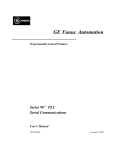Download Series 90-70, Factory LAN TCP/IP Ethernet Interface (Type 2
Transcript
Restarts for autonumbers that do not restart in each chapter. figure bi level 1, reset table_big level 1, reset chap_big level 1, reset app_big level 1, reset figure_ap level 1, reset table_ap level 1, reset figure level 1, reset table level 1, reset these restarts must be in the header frame of chapter 1. a:ebx, l 1 resetA a:obx:l 1, resetA a:bigbx level 1 resetA a:ftr level 1 resetA c:ebx, l 1 reset1 c:obx:l 1, reset1 c:bigbx level 1 reset1 c:ftr level 1 reset1 Reminders for autonumbers that need to be restarted manually (first instance will always be 4) let_in level 1: A. B. C. letter level 1:A.B.C. num level 1: 1. 2. 3. num_in level 1: 1. 2. 3. rom_in level 1: I. II. III. roman level 1: I. II. III. steps level 1: 1. 2. 3. December 15, 1997 GFK-1314F IMPORTANT PRODUCT INFORMATION READ THIS INFORMATION FIRST Product: IC697 Factory LAN Ethernet Interface (Type 2) IC697CMM742-FE IC697CMM742-EE Firmware Version 2.60 This is release 2.60 of the IC697 Ethernet Interface (Type 2). This module provides network communications using the SRTP (Service Request Transfer Protocol) over standard TCP/IP (Transmission Control Protocol and Internet Protocol) on an Ethernet LAN (Local Area Network). The Ethernet Interface supports communications between IC697 PLCs and/or IC693 PLCs equipped with TCP/IP Ethernet Interfaces. The Ethernet Interface can also communicate with MS-DOS Programming Software for IC697 TCP/IP, Windows Programming Software, and applications which use the TCP/IP Host Communication Toolkit software. Features and benefits for this module include: H Higher performance compared to IC697CMM741—2 to 4 times higher throughput for data transfers between PLCs with identical Channel setups. Up to 32 simultaneous network connections—twice the number supported by IC697CMM741. H Unlike the IC697CMM741, configuration of the Ethernet Interface is fully supported within CPU configuration. Centralized IP network configuration management is also supported via standard BOOTP protocol. Centralized Domain Name management is supported via standard DNS protocol. H Three alternative Ethernet network ports are available on the IC697CMM742 Interface. Two of the network ports, the 10BaseT (twisted pair) and the 10Base2 (thin wire), require no external transceiver. In addition, a standard AUI port is available for use with an external user-supplied transceiver. Only one of the three network ports may be used at a time. H Support for Ethernet Global Data, a means by which one device, referred to as a producer, can share a portion of its internal memory with one or more other EGD-capable devices, referred to as consumers, at a regularly scheduled periodic rate. An in-depth description of this feature is available through Windows Programming Software Online Help (Version 2.00 or later). This feature requires IC697 CPU Release 7.20 or later as well as Windows Programming Software Version 2.00 or later. Release 2.60 provides a new feature, multiplegateways. Note that Windows Programming Software Version 2.10 is required to use this new feature. See New Software Features for other improvements included in this release. Important Product Information: IC697 Factory LAN Ethernet Interface (Type 2) 2 GFK-1314F December 15, 1997 Functional Compatibility The IC697CMM742 Interface is compatible with the following products: H IC697 CPU models 781, 782, 914, 915, 924, and 925 loaded with firmware versions 6.00 or higher. Limited Server-mode only operation is possible with older CPU models (731/2,771/2: 4.12; 780: 4.60). For some features, more recent CPU releases are required: h h h H H H H H H H H H H H H Ethernet Global Data: Name Resolution: SNTP timestamping of EGD: Release 7.20 or higher Release 7.00 or higher Release 7.80 or higher (Release 7.50 or higher for Redundancy systems) IC697 Ethernet Interface IC697CMM741 loaded with TCP/IP software IC651ENS042. IC693 Ethernet Interface IC693CMM321 MS-DOS Programming Software version 6.02 or higher (required to configure the Ethernet Interface). For some features, Windows Programming Software is required (see below). Windows Programming Software Version 1.00 or higher. For some features, higher versions are required: h h h h Ethernet Global Data: Version 2.00 or higher SNTP timestamping of EGD: Version 2.10 or higher Name Resolution : Version 2.00 or higher Multiple Gateways: Version 2.10 or higher Host Communications Toolkit (HCT) software products listed below.* Toolkit for Windows NT/95 C/C++ Applications (IC641SWP058) Toolkit for Windows 3.xx C/C++ Applications (IC641SWP052) Toolkit for HP-UX C Applications (IC641SWP054) Toolkit for DEC VAX/VMS C Applications (IC641SWP053) Toolkit for DEC Alpha AXP/VMS C/C++ Applications (IC641SWP057) Host Communication Drivers for Windows NT/95 (IC641SWP080, IC641SWP081) Host Communication Drivers for Windows (IC641SWP050, IC641SWP051) *Some versions of HCT do not support the ‘Send Information Report’ COMMREQ or Ethernet Global Data. Please refer to the appropriate HCT IPI document for more information. Hardware Identification EX7A1: 44A737150-G01 R07 Field Update Kit 44A739337-G03 Data Sheet GFK-1309D User Manuals GFK-1246B, TCP/IP Ethernet Communications for the IC697 PLC (Type 2) User’s Manual GFK-1186D, TCP/IP Ethernet Communications for the IC697 PLC Station Manager Manual 3 Important Product Information: IC697 Factory LAN Ethernet Interface (Type 2) GFK-1314F December 15, 1997 Operational Notes Network Bandwidth Utilization Due to its performance potential, the IC697CMM742 Interface can present a heavy load on the network segment at its maximum operating capacity. Both Ethernet Global Data and Channel operation can contribute to an extremely high rate of network traffic when even a few such modules are involved. The potentially high network bandwidth utilization can cause a higher-than-normal rate of network collisions which may cause timeouts on data transfers. By configuring transfer timing to no more than you need, you can minimize such problems. For Ethernet Global Data operation, it is strongly recommended that caution be taken when defining exchange parameters. In particular, period values should be set to the required rates for your particular application instead of ‘as fast as possible’ rates. For Channel operation, it is strongly recommended that caution be taken when using multiple connections operating in an ‘as fast as possible’ mode. Tests conducted at the factory showed that 32 simultaneous Channels transferring 2 Kilobytes of data per Channel between two IC697CMM742’s can use up as much as 18% of the total network bandwidth when the Channels are all configured to run ‘as fast as possible’ using 91x or 92x CPUs. Network administrators consider 30% the threshold of Ethernet network overload. If your application requires many simultaneous network connections between IC697CMM742 Interfaces, it is recommended that the ‘minimum interval between host accesses’, ‘read period’, and ‘write period’ used in COMMREQs be set to the required rate for your particular application instead of ‘as fast as possible’. This will reduce the risk of overloading the network with traffic to and from the IC697CMM742 Interface. CPU Performance Limitation Again, due to its performance potential, the IC697CMM742 Interface can present a heavy load on the CPU at its maximum operating capacity. It is strongly recommended that caution be taken when using multiple connections operating in an “as fast as possible’”mode especially when a model 781 or 782 CPU is used. The COMMREQ Status Word (CRS Word) may occasionally become FE07 or FE87, which means service requests are made to the CPU faster than the CPU can process them. Although communications will proceed to the next repetition even when this is encountered, data transfer for the current repetition of this connection would have failed to complete. To avoid this situation, configure the “minimum interval between host accesses”, “read period”, or “write period” to a larger value so the CPU has enough time to process all service requests. Also, issuing a large number of COMMREQs to one Interface in one sweep may result in temporary resource exhaustion within the CPU, the Ethernet Interface, or both. If this occurs, the PLC logs a fault in the PLC fault table with fault group of “Option Module Software Failure” and error code equal 2 indicating that the COMMREQ frequency is too high. When this occurs, the ”FT” output of the COMMREQ function block will also be set. It is recommended to use logic that staggers the execution of COMMREQs across multiple sweeps so that a limited number of COMMREQs (typically 8 or less) are sent to a given board in each sweep. In addition, the FT output parameter should be checked for errors. If the FT output is set (meaning an error has been detected), the CommReq can be re-issued by the application logic. Important Product Information: IC697 Factory LAN Ethernet Interface (Type 2) 4 GFK-1314F December 15, 1997 Use of Windows Programming Software “Store” Function When performing a Store to PLC operation from Windows Programming Software Version 2.0 to a PLC system that contains an IC697CMM742 Interface. we make the following important operational recommendation regarding the Hardware Config components that appear within the Folder tab: Every Hardware Config component that appears in the Store dialog must always be selected when performing a Store operation. Failure to follow this recommendation may result in unexpected operation of Ethernet Global Data and Name Resolution features. (Note: this guideline does not apply to Store operations that include only Global Vars and/or Resource, which are not Hardware Config components.) Channel Data Transfer with One Repetition can Exhaust TCP Connections Because tearing down a TCP connection is time consuming, it is possible that programming your ladder in a certain way can quickly exhaust all available TCP connections. This can be avoided by programming your COMMREQs in a slightly different way. Your ladder can benefit from this reprogramming if: H The number of repetitions (word 9 in an Establish Read Channel or Establish Write Channel COMMREQ) is set to one (1) and a new COMMREQ is issued immediately upon completion of the prior one. H H Each successive COMMREQ is directed to the same target device (same IP address). Each successive COMMREQ is directed to the same channel number. To avoid TCP connection exhaustion you should set the number of repetitions (COMMREQ word 9) to two (2) and set the read/write period (COMMREQ words 10 and 11) to be very large, such as 60 seconds. With these parameters you can issue the first COMMREQ, wait for the COMMREQ Status (CRS) word to turn to one (1), then issue the next COMMREQ, wait for the CRS word to turn to one, etc., and there will not be TCP connection exhaustion problems. Interrupting an active channel allows the reuse of an existing TCP connection, while a repetition count of one starts the time-consuming TCP connection teardown immediately upon completion of the first transfer. You will also achieve faster response, as a new connection need not be established for each transfer. AUI Cable Removal Power to the PLC must be turned off whenever the transceiver cable (AUI cable) is connected or disconnected at the IC697CMM742 Interface AUI port or at the transceiver. SQE Enable If the AUI network port is used, the IC697CMM742 Interface requires that the SQE test be enabled on the external transceiver connecting it to the Ethernet LAN. Make sure your transceiver has SQE enabled. Otherwise, the Ethernet Interface will not go online and will log a “LAN Severe Network Problem; Attempting Recovery” fault. 5 Important Product Information: IC697 Factory LAN Ethernet Interface (Type 2) GFK-1314F December 15, 1997 Ethernet Interface PLC Installation Restrictions The IC697CMM742 Interface may not be used in an IC697 PLC expansion rack. The Ethernet Interface will not function properly if placed there. There may be no more than four (4) LAN Interfaces in a single PLC. This limit applies to the total number of IC697CMM721, IC697CMM731, IC697CMM741, IC697BEM741, and IC697CMM742 boards in the PLC. PLC Power Supply Requirements If the AUI network port is used, the IC697CMM742 Interface requires that the PLC include a power supply which supplies 12Vdc (IC697PWR711,-724, or -748). (note: if an externally powered transceiver is used on the AUI network port, 12Vdc is not required but an erroneous ‘blown fuse’ fault will appear in the CPU fault table.) Special Notes on Release 6 CPUs When your ladder program accesses %P and %L memories through COMMREQs, and a Release 6.00 CPU is used on the server PLC, the COMMREQ Status Word (CRS Word) may occasionally return F405. If this occurs, temporary relief may be obtained by cycling power on the server PLC. Permanent relief requires a CPU firmware upgrade to 6.02 or greater. Some PLC Fault Table Entries are Imprecise In the PLC Fault Table display of the IC641 Programming software, the following messages may not provide a meaningful description of the problem for the Ethernet Interface: H H H H “LAN PROM/software mismatch; running soft Sw util” “LAN system-software fault; resuming” “LAN Severe Network Problem; Attempting Recovery” “Module software corrupted; requesting reload” Should you see these messages, select the message and enter F10 (ZOOM) or CTRL+F to display the error codes associated with the message. Then refer to GFK-1186D, Appendix B: “Exception Log Event Description” for an accurate explanation of the error codes. (For IC697CMM742-EE only) 802.3 Specifications The IEEE 802.3 specification for isolation voltage of the 10BaseT network port is 1500 Vac and 2250 Vdc. The measured value for the IC697CMM742-EE is 1000 Vac and 1200 Vdc. Important Product Information: IC697 Factory LAN Ethernet Interface (Type 2) 6 GFK-1314F December 15, 1997 New Software Features Multiple Gateways Multiple Gateways support communications between PLCs on different subnets interconnected by gateways (sometimes called routers). An Ethernet Interface with the Multiple Gateways feature has the ability to route packets not only through a single default gateway, but also through additional gateways located on the local subnet. This feature requires Windows Programming Software Version 2.10 or later. A more detailed description of Multiple Gateways is available through the Windows Programming Software Online Help. SNTP Timestamping of Ethernet Global Data Exchanges This release of the IC697CMM742 Ethernet Interface can provide SNTP-supplied time value in the timestamps of Ethernet Global Data exchanges. A central SNTP server can be used to supply time to listening stations periodically, permitting participating stations to maintain synchronized clocks, thus providing consistency of Ethernet Global Data timestamps across participating stations. This feature requires IC697 CPU Release 7.80 or later (Release 7.50 or later for Redundancy systems) as well as Windows Programming Software Version 2.10 or later. A detailed description of this feature can be found in Changes and Additions to the User’s Manual, later in this document. Increased LLC Transmit Queue Length The default length of the LLC transmit ring has been increased from 23 (8) frames to 27 (128) frames. Log Event c, entry 2 = 10f may have been witnessed during extremely heavy traffic conditions on the Local Area Network when the length was 8. Increased Station Manager Command Recall The Station Manager now maintains a list of the 10 most recently issued commands. The keystroke CTRL+R can be repeated to scroll through the list of previous commands. The command list is not saved across module restarts or power cycles. 7 Important Product Information: IC697 Factory LAN Ethernet Interface (Type 2) GFK-1314F December 15, 1997 Problems Corrected in This Release (2.60) ÁÁÁÁÁÁÁÁÁÁÁÁÁÁÁÁÁÁÁÁÁÁÁÁÁÁÁÁÁÁÁ ÁÁÁÁ ÁÁ ÁÁÁÁÁÁÁÁÁÁÁÁÁÁÁÁÁÁÁÁÁÁÁÁÁ ÁÁÁÁÁÁÁÁÁÁÁÁÁÁÁÁÁÁÁÁÁÁÁÁÁÁÁÁÁÁÁ ÁÁÁÁÁÁÁÁÁÁÁÁÁÁÁÁÁÁÁÁÁÁÁÁÁ ÁÁÁÁÁÁ ÁÁÁÁÁÁÁÁÁÁÁÁÁÁÁÁÁÁÁÁÁÁÁÁÁÁÁÁÁÁÁ ÁÁÁÁ ÁÁ ÁÁÁÁÁÁÁÁÁÁÁÁÁÁÁÁÁÁÁÁÁÁÁÁÁ ÁÁÁÁÁÁÁÁÁÁÁÁÁÁÁÁÁÁÁÁÁÁÁÁÁÁÁÁÁÁÁ ÁÁÁÁÁÁÁÁÁÁÁÁÁÁÁÁÁÁÁÁÁÁÁÁÁ ÁÁÁÁÁÁ ÁÁÁÁ ÁÁ ÁÁÁÁÁÁÁÁÁÁÁÁÁÁÁÁÁÁÁÁÁÁÁÁÁ ÁÁÁÁ ÁÁ ÁÁÁÁÁÁÁÁÁÁÁÁÁÁÁÁÁÁÁÁÁÁÁÁÁ ÁÁÁÁ ÁÁÁÁÁÁÁÁÁÁÁÁÁÁÁÁÁÁÁÁÁÁÁÁÁ ÁÁ ÁÁÁÁÁÁÁÁÁÁÁÁÁÁÁÁÁÁÁÁÁÁÁÁÁÁÁÁÁÁÁ ÁÁÁÁÁÁÁÁÁÁÁÁÁÁÁÁÁÁÁÁÁÁÁÁÁ ÁÁÁÁÁÁ ÁÁ ÁÁÁÁÁ ÁÁÁÁÁÁÁÁÁÁÁÁÁÁÁÁÁÁÁÁÁÁÁÁÁÁ ÁÁÁÁÁÁÁÁÁÁÁÁÁÁÁÁÁÁÁÁÁÁÁÁÁÁÁÁÁÁÁ ÁÁÁÁ ÁÁ ÁÁÁÁÁÁÁÁÁÁÁÁÁÁÁÁÁÁÁÁÁÁÁÁÁ ÁÁÁÁÁÁÁÁÁÁÁÁÁÁÁÁÁÁÁÁÁÁÁÁÁÁÁÁÁÁÁ ÁÁÁÁÁÁÁÁÁÁÁÁÁÁÁÁÁÁÁÁÁÁÁÁÁÁÁÁÁÁÁ ÁÁÁÁ ÁÁ ÁÁÁÁÁÁÁÁÁÁÁÁÁÁÁÁÁÁÁÁÁÁÁÁÁ ÁÁÁÁ ÁÁ ÁÁÁÁÁÁÁÁÁÁÁÁÁÁÁÁÁÁÁÁÁÁÁÁÁ ÁÁÁÁ ÁÁ ÁÁÁÁÁÁÁÁÁÁÁÁÁÁÁÁÁÁÁÁÁÁÁÁÁ ÁÁÁÁÁÁÁÁÁÁÁÁÁÁÁÁÁÁÁÁÁÁÁÁÁÁÁÁÁÁÁ ID Code Description CR60889 The limit of 16 ARP table entries can result in unnecessary transmission delays and network traffic when a PLC needs to communicate with more than 16 other hosts. The size of the ARP cache has been increased to 256. CR62254 Memory buffers may be lost when Channels are arbitrarily re-tasked while they are active. CR63505 Under certain rare conditions, a frame received from the Ethernet network may not be immediately processed by the Ethernet Interface. All frames are now queued for immediateprocessing. CR62481 CR62555 CR62990 Name Resolution information, the Adapter Name list, the Aliases name list and the Interface’s Adapter Name, was retained even when a new configuration that contained no Name Resolution information was stored. Now that authoritative Name Resolution information is always obtained from the PLC CPU, the CHMYNAME and CHNAMETBL Station Manager commands have been disabled. This means that Name Resolution information must always be entered at the PLC Programmer and stored into the PLC. CR61481 PLC fault table entries for Ethernet Global Data fault conditions have been made more descriptive. The entries are described in Table B-2 within Appendix B of GFK-1186D. CR62846 The Station Manager commands STAT G and XCHANGE should use the dotted-decimal form to display the EGD Producer ID, similar to its usage in the Windows Programming Software. CR63212 If the network name server cannot be accessed when EGD production is begun, any exchange which relies on name resolution is not activated, even if the name server becomes availablelater. In this release, the name resolution continues to be retried and the exchange production will begin when the name is resolved successfully. Important Product Information: IC697 Factory LAN Ethernet Interface (Type 2) 8 GFK-1314F December 15, 1997 Restrictions and Significant Open Problems Open Problems in Release 2.60 Firmware ÁÁÁÁÁÁÁÁÁÁÁÁÁÁÁÁÁÁÁÁÁÁÁÁÁÁÁÁÁÁÁ ÁÁÁÁ ÁÁ ÁÁÁÁÁÁÁÁÁÁÁÁÁÁÁÁÁÁÁÁÁÁÁÁÁ ÁÁÁÁ ÁÁ ÁÁÁÁÁÁÁÁÁÁÁÁÁÁÁÁÁÁÁÁÁÁÁÁÁ ÁÁÁÁÁÁÁÁÁÁÁÁÁÁÁÁÁÁÁÁÁÁÁÁÁÁÁÁÁÁÁ ÁÁÁÁ ÁÁ ÁÁÁÁÁÁÁÁÁÁÁÁÁÁÁÁÁÁÁÁÁÁÁÁÁ ÁÁÁÁ ÁÁ ÁÁÁÁÁÁÁÁÁÁÁÁÁÁÁÁÁÁÁÁÁÁÁÁÁ ÁÁÁÁÁÁ ÁÁÁÁÁÁÁÁÁÁÁÁÁÁÁÁÁÁÁÁÁÁÁÁÁ ÁÁ ÁÁÁÁ ÁÁÁÁÁÁÁÁÁÁÁÁÁÁÁÁÁÁÁÁÁÁÁÁÁ ÁÁÁÁ ÁÁ ÁÁÁÁÁÁÁÁÁÁÁÁÁÁÁÁÁÁÁÁÁÁÁÁÁ ÁÁÁÁÁÁÁÁÁÁÁÁÁÁÁÁÁÁÁÁÁÁÁÁÁÁÁÁÁÁÁ ÁÁÁÁÁÁ ÁÁÁÁÁÁÁÁÁÁÁÁÁÁÁÁÁÁÁÁÁÁÁÁÁ ÁÁÁÁÁÁÁÁÁÁÁÁÁÁÁÁÁÁÁÁÁÁÁÁÁÁÁÁÁÁÁ ÁÁÁÁÁÁÁÁÁÁÁÁÁÁÁÁÁÁÁÁÁÁÁÁÁ ÁÁÁÁ ÁÁ ÁÁÁÁ ÁÁ ÁÁÁÁÁÁÁÁÁÁÁÁÁÁÁÁÁÁÁÁÁÁÁÁÁ ÁÁÁÁÁÁÁÁÁÁÁÁÁÁÁÁÁÁÁÁÁÁÁÁÁÁÁÁÁÁÁ ÁÁÁÁÁÁÁÁÁÁÁÁÁÁÁÁÁÁÁÁÁÁÁÁÁ ÁÁÁÁ ÁÁ ÁÁÁÁ ÁÁ ÁÁÁÁÁÁÁÁÁÁÁÁÁÁÁÁÁÁÁÁÁÁÁÁÁ ÁÁÁÁ ÁÁ ÁÁÁÁÁÁÁÁÁÁÁÁÁÁÁÁÁÁÁÁÁÁÁÁÁ ÁÁ ÁÁÁÁ ÁÁÁÁÁÁÁÁÁÁÁÁÁÁÁÁÁÁÁÁÁÁÁÁÁ ÁÁÁÁÁÁÁÁÁÁÁÁÁÁÁÁÁÁÁÁÁÁÁÁÁÁÁÁÁÁÁ ÁÁÁÁÁÁÁÁÁÁÁÁÁÁÁÁÁÁÁÁÁÁÁÁÁ ÁÁÁÁ ÁÁ ÁÁÁÁÁÁÁÁÁÁÁÁÁÁÁÁÁÁÁÁÁÁÁÁÁÁÁÁÁÁÁ ID Code Description CR54556 The IC697CMM742 Interface can not communicate with the local PLC CPU when a PLC load or a store operation is in progress. A PLC load or store operation (via MS-DOS Programmer WSI, Serial, and/or Ethernet or Windows Programmer either serial or Ethernet) has priority over all other communications. During a PLC load or store operation, it is possible for channels or server connections to experience time out errors, which may lead to disconnections. Possible exception log entries include log event 8, entry 2 = 8, 38, or 40. Whenever these backplane errors are logged, there are likely to also be additional exception logs for terminated TCP connections and SRTP Server and Channel API errors. Application programs should always be written to detect and recover from time out conditions. CR63808 Under very heavy Channel load conditions, LAN system software faults are intermittently reported. The reported exception log entry is log event 8, entry 2 = 39, entry 3 = fff5. This has been observed in an application with 32 Write Channels of 1024 bytes each, updating and “retasking” as quickly as possible. Channel operation continues without errors. CR64052 While a local Station Manager “TRACE LZ” troubleshooting command is in effect at an Ethernet Interface, do not issue Station Manager “REM <node> TEST” commands to it from a remote Interface. Doing so can cause errant behavior, including module lockup and loss-of-module in the PLC fault table. CR64699 Storing Hardware Configuration that contains new or changed values for the Ethernet Interface’s configuration results in exception event 11/5 and corresponding PLC Fault Table entry, “Local request to send was rejected; discarded request”. This fault affects only DDP2 Name Resolution operation, with the result that the existence of duplicate DDP2 names on the network is detected at the time that communication to one of the duplicate-name stations is attempted, rather than at the time of Configuration store. 9 Important Product Information: IC697 Factory LAN Ethernet Interface (Type 2) GFK-1314F December 15, 1997 Changes and Additions to the User’s Manual (GFK-1246) SNTP Timestamping of EGD exchanges Release 2.50 (and later) of the IC697CMM742 Ethernet Interface can provide SNTP-supplied value in the timestamps of EGD exchanges. To enable this feature, Release 7.01 of MS-DOS Programming Software or Version 2.10 of Windows Programming Software must be used to configure the Ethernet Interface, and IC697 PLC CPU Release 7.80 or later (Release 7.50 or later for Redundancy systems) must be used. Each consumed EGD exchange contains a timestamp that indicates the time that the associated data sample was transferred to the Ethernet Interface by the producing CPU for transmission. For Ethernet Interface Release 2.00, the timestamp was set according to the PLC CPU’s local clock. For Ethernet Interface Release 2.50, the timestamp can optionally be set using a clock value supplied by a central user-supplied Simple Network Time Protocol (SNTP) time server on the network. By default, the PLC CPU’s local clock is used. To enable SNTP clock timestamping, select “SNTP” for the “Network Time Sync” field in the Ethernet Interface configuration. Doing so will cause the Ethernet Interface to listen for a broadcast clock value from an SNTP server. The clock value will be supplied to the PLC CPU for timestamping produced EGD exchanges. NOTE: the PLC CPU’s local clock is not affected by the SNTP-supplied clock value, and the Ethernet Interface module’s local clock is synchronized to the SNTP-supplied value. SNTP timestamping is enabled on a per module basis. The clock source for EGD exchanges produced through a particular Ethernet Interface is determined by the “Network Time Sync” field for that module. Any SNTP or NTP compliant server that supports broadcast/multicast operation may be used. The Ethernet Interface will synchronize to a server’s time after receiving two broadcast clock values within a 150 second period. The Ethernet Interface will store and maintain clock information for up to three servers in addition to the currently synchronized server. If a broadcast clock value is not received from the current server within 150 seconds, it will be considered “lost” and the Ethernet Interface will synchronize with another server if one is available. Also, if at any time two clock values are received from a lower-stratum server, the Ethernet Interface will synchronize to the new server’s time. The “SNTP” station manager command may be used to view server status information. The “CHSNTP” station manager command may be used to override the Ethernet Interface module’s automatic server selection strategy and identify specific server(s) to be used. See “TCP/IP Ethernet Communications for the IC697 PLC Station Manager Manual “ GFK-1186D for details. If SNTP time synchronization is selected and no broadcast value is received within a 150 second period, the Ethernet Interface determines that no SNTP-supplied time is currently available for EGD timestamping. In this case, an entry is made in the PLC Fault Table and in the Ethernet Interface exception log. (The fault text is “User Application Fault” or “LAN system-software fault; resuming”, the log event code is “29”.) In this case, the Status word within a consumed exchange will indicate new data with the value “3” (instead of the value “1”), indicating that SNTP timestamping is enabled in the producing Ethernet Interface but that currently no server is available to it. The timestamp within the exchange will be based on one of two possible time bases: H H if the Ethernet Interface has not been able to synchronize to any SNTP server since its power-up/restart, it will use the PLC CPU’s local clock value at power-up/restart as the time base. if the Ethernet Interface has at some point been able to synchronize to a server, it will use the most recently received SNTP clock value from that server as the time base. Important Product Information: IC697 Factory LAN Ethernet Interface (Type 2) 10 GFK-1314F December 15, 1997 In either case, the clock on the Ethernet Interface continues running based on the time base value last supplied. The Ethernet Interface also continues to supply the time value to the CPU for inclusion in produced exchanges. In addition, it continues to monitor SNTP messages, and will become synchronized when possible. One additional exchange status value is possible when STNP timestamping is in use. The value is described below: ÁÁÁÁÁÁÁÁÁÁÁÁ ÁÁÁÁÁÁÁÁÁÁÁÁÁÁÁÁÁÁÁ ÁÁÁÁÁÁÁÁÁÁÁÁ ÁÁÁÁÁÁÁÁÁÁÁÁÁÁÁÁÁÁÁ ÁÁÁÁÁÁÁÁÁÁÁÁ ÁÁÁÁÁÁÁÁÁÁÁÁÁÁÁÁÁÁÁ ÁÁÁÁÁÁÁÁÁÁÁÁ ÁÁÁÁÁÁÁÁÁÁÁÁÁÁÁÁÁÁÁ ÁÁÁÁÁÁÁÁÁÁÁÁ ÁÁÁÁÁÁÁÁÁÁÁÁÁÁÁÁÁÁÁ ÁÁÁÁÁÁÁÁÁÁÁÁ ÁÁÁÁÁÁÁÁÁÁÁÁÁÁÁÁÁÁÁ ÁÁÁÁÁÁÁÁÁÁÁÁ ÁÁÁÁÁÁÁÁÁÁÁÁÁÁÁÁÁÁÁ ÁÁÁÁÁÁÁÁÁÁÁÁ ÁÁÁÁÁÁÁÁÁÁÁÁÁÁÁÁÁÁÁ STATUS VALUE DESCRIPTION NEW_DATA/NO_ERROR_TIME_UNSYNC ‘producer’ exchange:N/A. (3) ‘consumer’ exchange: Since the last I/O scan, new data has arrived over the network. However, the producer of the exchange is configured for network time synchronization, but not actually synchronized to the network time. Therefore, the timestamp which goes along with the new data is not synchronized to the network. This error condition is considered the least important - if another error condition exists, its error code will appear in the status value. Special Notes on Using IC697CMM742 with PLC CPUs (Versions 4.12 - 5.50) The IC697CMM742 Ethernet Interface (Type 2) is designed for high-performance operation and convenient installation with IC697 PLC CPU versions 6.00 and later. These PLC CPUs recognize and support the Ethernet Interface (Type 2), and provide the high throughput demanded by this product. GE Fanuc recommends use of IC697 PLC CPUs with version 6.00 and later firmware to obtain the full capabilities of the Ethernet Interface (Type 2). Versions 1.10 and later of the Ethernet Interface (Type 2) also provide restricted operation with IC697 PLC CPUs running firmware versions 4.12 through 5.50. These notes describe the necessary Ethernet Interface configuration and restricted operation with these PLC CPUs. The Ethernet Interface (Type 2) cannot be used with PLC CPU firmware versions prior to 4.12. Ethernet Interface Installation and Configuration The Ethernet Interface (Type 2) is installed in the main PLC rack as described in Procedure 1 in Chapter 2 of the TCP/IP Ethernet (Type 2) Users Manual. IC697 PLC CPU firmware versions 4.12 though 5.50 do not accept PLC configuration data for the Ethernet Interface (Type 2). Thus, this Ethernet Interface cannot be configured as described in Procedure 2 in Chapter 2 of the User’s Manual. An alternate Procedure 2 is provided below; this procedure uses a user-supplied computer terminal or equivalent plus the Station Manager software within the Ethernet Interface to enter the necessary configuration data. The Station Manager is completely described in the TCP/IP Ethernet Station Manager Manual. Please refer to this manual for complete details on connecting a terminal to the Station Manager serial port of the Ethernet Interface, and on the various Station Manager commands used within this alternate Procedure 2. 11 Important Product Information: IC697 Factory LAN Ethernet Interface (Type 2) GFK-1314F December 15, 1997 Alternate Procedure 2: Configuring the Ethernet Interface (with PLC CPU versions 4.12 through 5.50) IC697 PLC CPU firmware versions prior to version 6.00 do not accept configuration data for the Ethernet Interface (Type 2). Thus the Ethernet Interface (Type 2) cannot be configured by the IC641 PLC Configuration software. Instead, a dummy module must be configured in place of the Ethernet Interface; the Station Manager software within the Ethernet Interface is then used to enter configuration data directly at the module. First, create a dummy entry in the PLC Configuration for the rack and slot where the Ethernet Interface is installed. 1. Connect a PC running the IC641 PLC Configuration software to the PLC via the built-in serial port on the PLC CPU module. Then access the I/O Configuration screen of the IC641 PLC Configuration software. 2. 2Move the cursor to the rack and slot where the Ethernet Interface (Type 2) is installed. This slot must be configured as a “3rd Party VME module” as follows: From the I/O Configuration screen, press the vme soft key (F7). From the next screen, press the vme soft key (F1), then move the cursor to the 3RD PARTY VME MODULE selection and press the Enter key to select. Press the Escape key to return to the I/O Configuration screen. The slot containing the Ethernet Interface will be displayed as “3PY VME”. If there is no vme soft key in the I/O Configuration screen, configure the rack and slot where the Ethernet Interface (Type 2) is installed as a “Blank jumper” as follows: Press the m70_io soft key (F1). From the next screen, press the other soft key (F7), then move the cursor to the BLANK SLOT INTERRUPT JUMPER selection and press the Enter key to select. Press the Escape key to return to the I/O Configuration screen. The slot containing the Ethernet Interface will be displayed as “JUMPER”. 3. Press the Escape key to save the PLC configuration to disk. 4. Use of the dummy module type above will always result in a Configuration Mismatch error at each power up, configuration store, or Ethernet Interface restart. To prevent this error from putting the PLC into STOP/FAULT state, change the severity of this error as follows: From the main PLC Configurator screen, press the cpu soft key (F2) to display the CPU configuration, then press the fltcfg key (F5) to display the Fault Categories. Press the down arrow key () repeatedly until Fault Type is “System Config Mismatch”, then press the Tab key to change the Fault Category from “F” (= Fatal) to “D” (= Diagnostic). Press the Escape key twice to store the fault categories to the PLC CPU and return to the main PLC Configurator screen 5. Store the PLC configuration to the PLC. Now configure the Ethernet Interface (Type 2) locally using its onboard Station Manager. Refer to the TCP/IP Ethernet Station Manager Manual for complete information on Station Manager operation. 6. Connect a standard ASCII terminal or PC-based terminal emulator to the Station Manager (RS-232) serial port on the Ethernet Interface. Use the NODE Station Manager command to verify that the terminal or emulator is properly Important Product Information: IC697 Factory LAN Ethernet Interface (Type 2) 12 GFK-1314F December 15, 1997 communicating with the Station Manager software in the Ethernet Interface. A typical NODE command is shown below: > node IC697 PLC Factory LAN Ethernet Interface (Type 2) Copyright (c) 1996. All rights reserved. Version 1.10 (25A1) TCP/IP Version 1.00 (12A1) Software Loader IP Address = 0.0.0.0 MAC Address = 080019010688 *** PLC CPU version (5.00) supports restricted LAN Interface operation: *** SRTP server only (client operation is not permitted) *** LAN Interface cannot be configured with PLC Configurator *** (Use CHSOSW Station Manager cmd to enter module configuration) *** PLC CPU version 6.00 or higher is required for full operation If the Ethernet Interface has not been previously configured, the NODE output will also indicate that the Ethernet Interface is waiting for a valid IP address. 7. Use the LOGIN Station Manager command to “log in” in order to access the Modify-level commands needed later. The LOGIN command is shown below: > login After entering the LOGIN command, the Station Manager prompts for the Modify-level password: Password: Enter your password (which is not echoed). The default password is: system (lower case). If the password matches the current Modify-level password, a confirmation message is displayed; the Station Manager prompt changes from “>” to “=”. 8. Use the Modify-level MAINT Station Manager command to restart the Ethernet Interface into the Maintenance state. The MAINT command is shown below: = maint Restarting module into Maintenance state The Ethernet Interface is restarted into the Maintenance state. After approximately 20 seconds, another NODE output is automatically generated when the restart is complete. The display will also indicate that the Ethernet Interface is in the Maintenance state; the Station Manager prompt is “*”. Modify-level login is not required in the Maintenance state. Important Product Information: IC697 Factory LAN Ethernet Interface (Type 2) GFK-1314F 9. 13 December 15, 1997 Use the CHSOSW Station Manager commands to enter the configuration data for this Ethernet Interface. The IP addressing parameters ( ip_address, subnet_mask, gateway, and name_server) must be set to values supplied by the person in charge of your network ( the network administrator). TCP/IP network administrators are familiar with these parameters. It is important that these parameters are correct, otherwise the Ethernet Interface may be unable to communicate on the network and/or network operation may be corrupted. It is especially important that each node on the network is assigned a unique IP address. Enter the IP Address as follows: * chsosw ip_address <a.b.c.d> where <a.b.c.d> is the unique dotted decimal IP address for this node. Enter the Subnet Mask as follows: * chsosw subnet_mask <a.b.c.d> where <a.b.c.d> is the dotted decimal subnet mask for this network segment. Enter the Gateway IP Address as follows: * chsosw gateway <a.b.c.d> where <a.b.c.d> is the unique dotted decimal IP address of the gateway device. Enter the Name Server IP Address as follows: * chsosw name_server <a.b.c.d> where <a.b.c.d> is the unique dotted decimal IP address of the name server device. The CHSOSW command may also be used to change the parameters for either serial port on the Ethernet Interface in cases where the default serial port configuration values are not used. Refer to the TCP/IP Ethernet Station Manager Manual for further information. A typical CHSOSW command is shown below: * chsosw ip_address 3.0.0.1 Once entered, the configuration parameters are retained in non-volatile flash memory for use each time the Ethernet Interface is powered up or restarted. Configuration needs to be re-entered only when changing one or more configuration parameters. 14 Important Product Information: IC697 Factory LAN Ethernet Interface (Type 2) GFK-1314F December 15, 1997 10. Use the SOSW Station Manager command to verify that all configuration parameters have been set to the proper values. A typical SOSW command is shown below: * sosw <<< Soft Switch Data >>> IP Address Switches) Subnet Mask Gateway Name Server = 3.0.0.1 (TCP/IP values from Soft = 0.0.0.0 = 0.0.0.0 = 0.0.0.0 Port 1 (Station Manager): Data Rate = 9600 Parity = NONE Stop Bits = 1 Flow Control = NONE TurnA Delay = NONE Timeout = LONG Port 2 (S/W Loader): Data Rate = 19200 Parity = ODD Stop Bits = 1 Flow Control = NONE TurnA Delay = NONE Timeout = LONG Source of Soft Switches: Internal Backup 11. When all configuration parameters have been correctly entered, use the RESTART Station Manager command to restart the Ethernet Interface into normal operation. The RESTART command is shown below: = restart Restarting module The Ethernet Interface is restarted into the Operational state. After approximately 20 seconds, another NODE output is automatically generated when the restart is complete. The NODE output should indicate the IP Address configured in Step 9, above. (The Subnet Mask, Gateway IP Address and Name Server IP Address can be displayed by the SOSW command, as described in Step 10, above.) The Ethernet Interface is now properly configured and ready for use. Please proceed to Procedure 3 in Chapter 2 of the User’s Manual to verify proper operation of the Ethernet Interface with the new configuration data. 15 Important Product Information: IC697 Factory LAN Ethernet Interface (Type 2) GFK-1314F December 15, 1997 Ethernet Interface Operational Restrictions The Ethernet Interface (Type 2) operates with some restrictions when used with IC697 PLC CPU versions 4.12 through 5.50. These Operational Restrictions, together with differences in Startup, Station Manager and Software Loader operation, are described below. 1. COMMREQ operation is not supported. Any COMMREQ issued to the Ethernet Interface is ignored; a COMMREQ Status (CRS) word is not returned to the PLC. Instead, the Ethernet Interface generates an event in its internal exception log (Event = 1c; Entry 2 = 0011) indicating that the Channel API task is not active. The Ethernet Interface also generates an entry in the PLC Fault Table: (“LAN system-software fault; resuming”) 2. The Ethernet Interface returns neither LAN Interface Status (LIS) nor Channel Status data to the PLC. 3. PLC CPU models IC697CPU73x and IC697CPU77x may limit the overall performance of a PLC used as a server device. Under heavy load from other clients and hosts on the network, the server PLC may generate errors with major error code 07, indicating that the volume of requests from the network have momentarily exceeded the processing capacity of the PLC CPU. The request will need to be retried. If possible, try to reduce the volume of requests to the server PLC when this condition occurs. If the system design requires data rates beyond the capacity of the server PLC CPU, please consider upgrading to a more powerful CPU model. Startup 1. Upon each powerup or restart of the Ethernet Interface, or configuration store to the PLC, the following entry will be generated in the PLC Fault Table for the slot containing the Ethernet Interface: (“Reset of, addition of, or extra option module”). 2. When operating with PLC CPU versions prior to 6.00, the Ethernet Interface does not generate the exceptions or PLC Faults that normally occur when Ethernet Interface does not receive module configuration from the PLC CPU. 3. Each powerup and restart of the Ethernet Interface takes approximately 20 seconds. This is roughly 10 seconds longer than required when the Ethernet Interface is used with PLC CPU versions 6.00 and later. Station Manager 1. The STAT C command (PLC Driver status) does not display the current PLC CPU state (RUN/STOP and I/O ENABLED/ I/O DISABLED). 2. In the TALLY C command output (PLC Driver tallies), the “PlcSweep” tally does not count the number of PLC sweeps. This tally should be ignored. 3. The STAT H command (Channel API status) always indicates “Channel API task not initialized” 4. As detailed above in the Ethernet Interface Installation and Configuration section, special restricted operation notification is displayed with the startup message and by the NODE command. 16 Important Product Information: IC697 Factory LAN Ethernet Interface (Type 2) GFK-1314F December 15, 1997 Software Loader IC697 PLC CPU versions 6.00 and later gracefully allow option modules like the Ethernet Interface to suspend communication with the PLC CPU while loading new firmware. Since this capability is not present in PLC CPU versions 4.12 - 5.50, special operations are required when loading new firmware into the Ethernet Interface. Follow the steps in Appendix E of the User’s Manual to load new firmware into the Ethernet Interface; step 2 of the firmware installation process must be expanded, as described below: .(from Appendix 2) Hold the Reset button on the Ethernet Interface until the bottom LED (STATUS) turns ON. Upon releasing the button, all 4 LEDs will blink in unison. This signifies that the Interface is in the Software Loader state. a.(new) After 18-20 seconds, the PLC CPU will indicate that communication with the Ethernet Interface has been lost. A PLC Fault Table entry will be generated “Loss of option module”; all LEDs on the Ethernet Interface will turn OFF and remain so indefinitely. 2b. (new) Press the Restart button again. The Ethernet Interface will restart immediately without any communication to the PLC CPU. The OK LED will blink, turn OFF, and blink again. After approximately two minutes, the Ethernet Interface will enter the Operational state. (The absence of PLC CPU communication is of no concern at this time.) c. (new) Hold the Reset button on the Ethernet Interface until the bottom LED (STATUS) turns ON. This time, upon releasing the button, the OK LED will blink for approximately 30 seconds, then all 4 LEDs will blink in unison to signify the Ethernet Interface is in the Software Loader state. The Ethernet Interface can now safely accept the firmware update. Proceed with Steps 3 through 9 in Appendix E of the User’s Manual. When the loading process is complete, the Ethernet Interface will automatically restart. Proceed to new Step 10 to restore communication between the PLC CPU and the Ethernet Interface. 10. (new) Once the Ethernet Interface begins to restart upon load completion (OK LED is blinking; other LEDs are OFF), turn the PLC power supply OFF and then ON; this is necessary to establish communication between the PLC CPU and the Ethernet Interface.
















